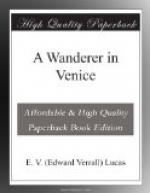Having visited the Giovanelli Palace, I found myself restless for this rare spirit, and therefore arranged a little diversion to Castel Franco, where he was born and where his great altar-piece is preserved.
But first let us look at Giorgione’s career. Giorgio Barbarelli was born at Castel Franco in 1477 or 1478. The name by which we know him signifies the great Giorgio and was the reward of his personal charm and unusual genius. Very little is known of his life, Vasari being none too copious when it comes to the Venetians. What we do know, however, is that he was very popular, not only with other artists but with the fair, and in addition to being a great painter was an accomplished musician. His master was Giovanni Bellini, who in 1494, when we may assume that Giorgione, being sixteen, was beginning to paint, was approaching seventy.
Giorgione, says Vasari in an exultant passage, was “so enamoured of beauty in nature that he cared only to draw from life and to represent all that was fairest in the world around him”. He had seen, says the same authority, “certain works from the hand of Leonardo which were painted with extraordinary softness, and thrown into powerful relief, as is said, by extreme darkness of the shadows, a manner which pleased him so much that he ever after continued to imitate it, and in oil painting approached very closely to the excellence of his model. A zealous admirer of the good in art, Giorgione always selected for representation the most beautiful objects that he could find, and these he treated in the most varied manner: he was endowed by nature with highly felicitous qualities, and gave to all that he painted, whether in oil or fresco, a degree of life, softness, and harmony (being more particularly successful in the shadows) which caused all the more eminent artists to confess that he was born to infuse spirit into the forms of painting, and they admitted that he copied the freshness of the living form more exactly than any other painter, not of Venice only, but of all other places.”




